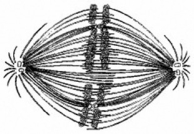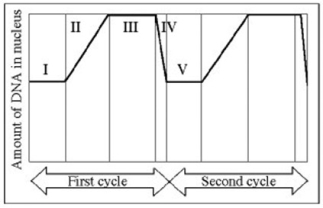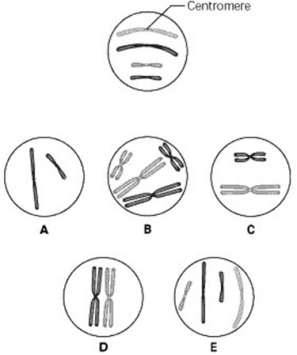A) G₁
B) S
C) G₂
D) G₀
F) None of the above
Correct Answer

verified
Correct Answer
verified
Multiple Choice
Certain cell types normally have several nuclei per cell. How could such multinucleated cells be explained?
A) The cell underwent repeated cytokinesis but no mitosis.
B) The cell underwent repeated mitosis with simultaneous cytokinesis.
C) The cell underwent repeated mitosis, but cytokinesis did not occur.
D) The cell had multiple S phases before it entered mitosis.
F) B) and C)
Correct Answer

verified
Correct Answer
verified
Multiple Choice
Use the figure to answer the question below.
 If the cell whose nuclear material is shown in the figure continues toward completion of mitosis, which of the following events would occur next?
If the cell whose nuclear material is shown in the figure continues toward completion of mitosis, which of the following events would occur next?
A) spindle fiber formation
B) nuclear envelope breakdown
C) formation of telophase nuclei
D) synthesis of chromatids
F) A) and C)
Correct Answer

verified
Correct Answer
verified
Multiple Choice
In a diploid cell with 5 chromosome pairs (2n = 10) , how many sister chromatids will be found in a nucleus at prophase of mitosis?
A) 5
B) 10
C) 20
D) 40
F) None of the above
Correct Answer

verified
Correct Answer
verified
Multiple Choice
At which phase of the cell cycle do centrioles begin to move apart in animal cells?
A) anaphase
B) telophase
C) metaphase
D) prophase
F) A) and D)
Correct Answer

verified
Correct Answer
verified
Multiple Choice
Taxol is an anticancer drug extracted from the Pacific yew tree. In animal cells, Taxol prevents microtubule depolymerization. Thus, Taxol stops mitosis by interfering with which of the following structures or processes?
A) the mitotic spindle
B) cytokinesis
C) centriole duplication
D) chromosome condensation
F) A) and B)
Correct Answer

verified
Correct Answer
verified
Multiple Choice
Which of the following molecules is a protein synthesized at specific times during the cell cycle that associates with a kinase to form a catalytically active complex?
A) PDGF
B) MPF
C) cyclin
D) Cdk
F) A) and C)
Correct Answer

verified
Correct Answer
verified
Multiple Choice
Use the figure to answer the question below.
 In the figure, at which of the numbered regions would you expect to find cells at metaphase?
In the figure, at which of the numbered regions would you expect to find cells at metaphase?
A) II and IV
B) II only
C) III only
D) IV only
F) A) and C)
Correct Answer

verified
Correct Answer
verified
Multiple Choice
G₁ is associated with which of the following cellular events?
A) normal growth and cell function
B) DNA replication
C) the beginning of mitosis
D) break down of the nuclear membrane
F) A) and B)
Correct Answer

verified
Correct Answer
verified
Multiple Choice
What would you expect to happen if MPF (maturation-promoting factor) is introduced into immature frog oocytes that are arrested in G₂?
A) The cells would remain arrested in G₂.
B) The cells would enter G₀.
C) The cells would enter mitosis.
D) The cells would begin DNA synthesis.
F) All of the above
Correct Answer

verified
Correct Answer
verified
Multiple Choice
In the cells of some organisms, mitosis occurs without cytokinesis. This will result in
A) cells with more than one nucleus.
B) cells that are unusually small.
C) cells lacking nuclei.
D) cell cycles lacking an S phase.
F) C) and D)
Correct Answer

verified
Correct Answer
verified
Multiple Choice
Early observations of a cultured cell line indicated that the cells did not exhibit either density-dependent inhibition or anchorage dependence. What do these observations suggest about this cell line?
A) The cells are unable to form spindle microtubules.
B) The cells follow an altered series of cell cycle phases.
C) The cells show characteristics of tumors.
D) The cells have nonfunctional MPF.
F) A) and D)
Correct Answer

verified
C
Correct Answer
verified
Multiple Choice
The M phase checkpoint ensures that all chromosomes are attached to the mitotic spindle. If this does not happen, cells would most likely be arrested in ________.
A) telophase
B) prophase
C) G₂
D) metaphase
F) A) and B)
Correct Answer

verified
D
Correct Answer
verified
Multiple Choice
The beginning of anaphase is indicated by which of the following processes?
A) Loss of kinetochores from the chromatids.
B) Attachment of sister chromatids to each other by cohesin.
C) Enzymatic cleavage of cohesin.
D) Disappearance of the nuclear membrane.
F) C) and D)
Correct Answer

verified
Correct Answer
verified
Multiple Choice
During which phase of mitosis do the chromatids become chromosomes?
A) telophase
B) anaphase
C) prophase
D) metaphase
F) B) and D)
Correct Answer

verified
Correct Answer
verified
Multiple Choice
In a diploid cell with 5 chromosome pairs (2n = 10) , how many centromeres will be found in a nucleus at G2 of the cell division cycle?
A) 5
B) 10
C) 20
D) 40
F) B) and D)
Correct Answer

verified
Correct Answer
verified
Multiple Choice
Use the figure to answer the question below.
The unlettered circle at the top of the figure shows a diploid nucleus with four chromosomes that have not yet replicated. There are two pairs of homologous chromosomes, one long and the other short. One haploid set is black, and the other is gray. The circles labeled A to E show various combinations of these chromosomes.
 What is the correct chromosomal condition at prometaphase of mitosis?
What is the correct chromosomal condition at prometaphase of mitosis?
A) B
B) C
C) D
D) E
F) A) and B)
Correct Answer

verified
A
Correct Answer
verified
Multiple Choice
Scientists isolate cells in various phases of the cell cycle. They isolate a group of cells that have 1 1/2 times more DNA than G₁ phase cells. What is the most likely part of the cell cycle from which these cells were isolated?
A) between the G₁ and S phases in the cell cycle
B) in the G₂ phase of the cell cycle
C) in the M phase of the cell cycle
D) in the S phase of the cell cycle
F) A) and B)
Correct Answer

verified
Correct Answer
verified
Multiple Choice
Which of the following events occurs during interphase of the cell cycle?
A) condensation of the chromosomes
B) separation of the spindle poles
C) spindle formation
D) replication of the DNA
F) A) and C)
Correct Answer

verified
Correct Answer
verified
Multiple Choice
The mitotic spindle plays a critical role in which of the following processes?
A) splitting of the cell (cytokinesis) following mitosis
B) triggering the compaction and condensation of chromosomes
C) dissolving the nuclear membrane
D) separation of sister chromatids
F) A) and C)
Correct Answer

verified
Correct Answer
verified
Showing 1 - 20 of 66
Related Exams